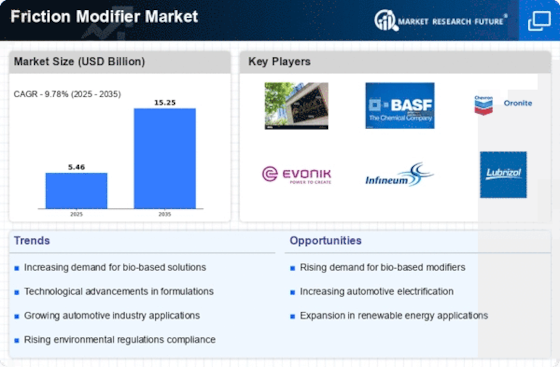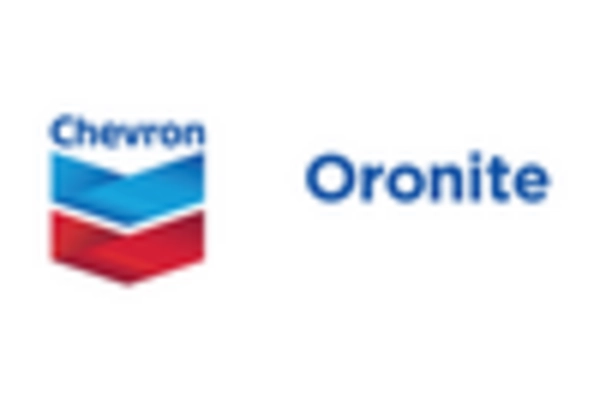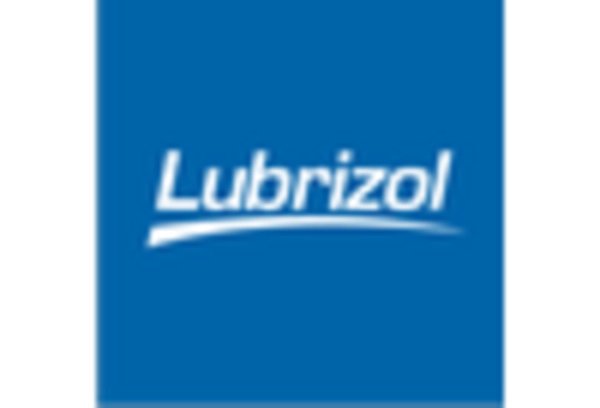Growth in Electric Vehicle Production
The Friction Modifier Market is poised for growth due to the increasing production of electric vehicles (EVs). As the automotive industry shifts towards electrification, the demand for specialized lubricants and additives, including friction modifiers, is expected to rise. EVs require unique formulations to ensure optimal performance and efficiency, particularly in their drivetrains. Market analysts project that the electric vehicle market will reach over 30 million units by 2030, creating substantial opportunities for the Friction Modifier Market. Manufacturers are likely to focus on developing friction modifiers that cater specifically to the needs of electric vehicles, thereby enhancing their market presence.
Rising Awareness of Energy Efficiency
The Friction Modifier Market is benefiting from a growing awareness of energy efficiency among consumers and businesses. As energy costs continue to rise, there is an increasing emphasis on reducing friction in mechanical systems to enhance performance and lower operational expenses. Friction modifiers play a crucial role in achieving these objectives by minimizing energy loss in various applications, from automotive engines to industrial machinery. This trend is reflected in the rising adoption of friction modifiers across multiple sectors, as companies seek to optimize their operations. The Friction Modifier Market is likely to see sustained growth as awareness of energy efficiency continues to permeate various industries.
Regulatory Pressure for Emission Reductions
The Friction Modifier Market is significantly influenced by stringent regulations aimed at reducing emissions from vehicles and industrial processes. Governments worldwide are implementing policies that mandate lower emissions, compelling manufacturers to adopt innovative solutions. Friction modifiers contribute to improved fuel efficiency, thereby aiding in compliance with these regulations. For instance, the European Union's stringent emission standards have prompted automotive manufacturers to seek advanced friction modifier formulations that enhance performance while minimizing environmental impact. This regulatory landscape is expected to drive growth in the Friction Modifier Market, as companies strive to develop products that align with these evolving standards.
Increasing Demand for High-Performance Lubricants
The Friction Modifier Market is experiencing a notable surge in demand for high-performance lubricants, driven by the automotive and industrial sectors. As manufacturers strive to enhance the efficiency and longevity of machinery, the incorporation of friction modifiers has become essential. Reports indicate that The Friction Modifier is projected to reach approximately 200 billion USD by 2026, with friction modifiers playing a pivotal role in this growth. These additives not only reduce wear and tear but also improve fuel efficiency, which is increasingly prioritized by consumers and regulatory bodies alike. Consequently, the Friction Modifier Market is likely to benefit from this trend, as companies invest in advanced formulations to meet the evolving needs of their clients.
Technological Innovations in Additive Manufacturing
The Friction Modifier Market is experiencing a wave of technological innovations, particularly in additive manufacturing processes. Advances in material science and formulation techniques are enabling the development of more effective friction modifiers that enhance performance and durability. These innovations are crucial as industries seek to improve the efficiency of their products while reducing costs. For instance, the introduction of nanotechnology in friction modifier formulations has shown promising results in enhancing lubrication properties. As manufacturers continue to invest in research and development, the Friction Modifier Market is expected to evolve, offering new solutions that meet the demands of modern applications.


















Leave a Comment